The feast is as old as humanity. In nature of old, fish and fruits and hunted animals and roots were not a constant convenience but bound to far-flung rhythms, hence the wandering of bands, the movement of tribes. When there was abundance, the community feasted together. It was a special time.
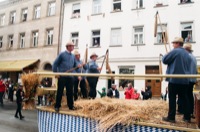
For nomads, abundant food was a matter of a specific season’s moon over a specific place. A plateau or a slope where a wild crop grew profusely year after year would hold special association for a feast, which feast would be more than eating and drinking – to feast was also, perhaps foremost, to give thanks.
Our oldest ancestors gave thanks to the essence, the spirit of plant or animal. Such spiritual connection intensified when shamans painted on cave walls, choreographed drumming and dancing, and formed fetishes from animal and plant parts. For example, nomads braided straw idols in the region that’s southern Turkey today, where grain grew wild for the harvesting, the very grain that would jump-start agriculture in the Fertile Crescent, Einkorn.
Our oldest ancestors gave thanks to the essence, the spirit of plant or animal. Such spiritual connection intensified when shamans painted on cave walls, choreographed drumming and dancing, and formed fetishes from animal and plant parts. For example, nomads braided straw idols in the region that’s southern Turkey today, where grain grew wild for the harvesting, the very grain that would jump-start agriculture in the Fertile Crescent, Einkorn.
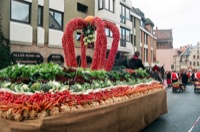
Einkorn was the first Farro. From Farro grains the wheats would later hybridize: one cannot imagine Middle Eastern and Western civilizations without Einkorn and its offspring Emmer bending to the will of the first farmers, who, their straw idols in hand, said thanks to and prayed for fertility of this wonderful grass.
Agriculture: the farming of grain crops enabled far greater population density than had been possible before. With settlement, land and property became more tangible. Paganism rose as a means to control masses of people, religion replacing animism, and now the people worshipped their grain through goddesses – Isis, Demeter, Ceres.
Agriculture: the farming of grain crops enabled far greater population density than had been possible before. With settlement, land and property became more tangible. Paganism rose as a means to control masses of people, religion replacing animism, and now the people worshipped their grain through goddesses – Isis, Demeter, Ceres.
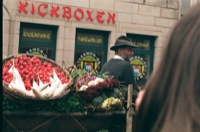
Though they kept on braiding straw idols.
Monotheistic religions came next, ever more brutal control over the populace. Thanksgivings moved to the altars of the one-god.
And still folks kept on crafting those straw idols, in some regions calling them “dolls” to divert attention from the original meaning of the idol. Eventually, straw idols metamorphosed to straw art accepted by Christianity when wheat weavers conjured up crosses and angels and other Christian images. When the Mennonites emigrated to Kansas they brought the art of wheat weaving with them, and on a small scale the craft is practiced in America to this day. In Europe, wheat weavings are popular as Christmas decor.
Monotheistic religions came next, ever more brutal control over the populace. Thanksgivings moved to the altars of the one-god.
And still folks kept on crafting those straw idols, in some regions calling them “dolls” to divert attention from the original meaning of the idol. Eventually, straw idols metamorphosed to straw art accepted by Christianity when wheat weavers conjured up crosses and angels and other Christian images. When the Mennonites emigrated to Kansas they brought the art of wheat weaving with them, and on a small scale the craft is practiced in America to this day. In Europe, wheat weavings are popular as Christmas decor.
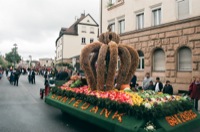
Large straw images also aroused bucolic emotions, Straw Man, Straw Bear, although over time these rituals had less to do with Thanksgiving; the reenactments taking place today are most often held in winter, some during Carnival. As for the tall Thanksgiving crowns of wheat sheaves, they still feature in Thanksgiving processions on Europe’s continent.
European Thanksgivings were held in October, often on the first weekend of the month, as for example the Franconian Erntedankfests that are celebrated to this day. On the church side, local farmers arrange a mound of colorful harvest bounty around the altar. More secular are the parades. Within and without church, sheaves and straw are important highlights of Thanksgiving.
European Thanksgivings were held in October, often on the first weekend of the month, as for example the Franconian Erntedankfests that are celebrated to this day. On the church side, local farmers arrange a mound of colorful harvest bounty around the altar. More secular are the parades. Within and without church, sheaves and straw are important highlights of Thanksgiving.
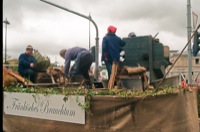
In America, of course, the Pilgrims-and-Indians theme plays over the harvest-thanksgiving concept. And maybe that’s a good thing, because we live in times of industrialized agriculture when supermarkets are (yet) full to the brim with global stuff, while labs churn out new DNA – to whom do we to say thanks, Texaco, Tyson, Walmart, Monsanto? Not that they wouldn’t like us to bow before them, instead, the public’s distrust of their corporations remains their perennial discontent.
Besides, what would we hold up as idols? Credit cards?
Another perspective on Thanksgiving is that viewed from the standpoint of Einkorn. After all, this first of the Triticum species struck a coevolutionary deal with the first-farmer humans: in exchange for larger kernels and the non-shattering trait which prolonged the harvest window, humans would serve Triticum as multiplier, carrying its seed en masse to the four corners of the world, farther than bird and mouse could disperse the species a kernel at a time.
Besides, what would we hold up as idols? Credit cards?
Another perspective on Thanksgiving is that viewed from the standpoint of Einkorn. After all, this first of the Triticum species struck a coevolutionary deal with the first-farmer humans: in exchange for larger kernels and the non-shattering trait which prolonged the harvest window, humans would serve Triticum as multiplier, carrying its seed en masse to the four corners of the world, farther than bird and mouse could disperse the species a kernel at a time.
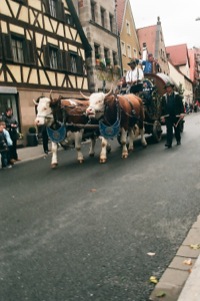
Talk about species spread success: with 651 million tons world production in 2010, the Triticum grains rank the most important global food source together with maize (844 million tons) and rice (679 million tons).
Alas, Einkorn would hardly recognize what passes for wheat these days. Industrialized hybridization and chemically-forced gene mutation shafted natural offspring, to the point where the venerable Einkorn and Emmer and Spelt Farro were relegated to bystander status in botanical books. You could smell the dust on the passages that cite the ancient grains.
Yet the past few decades of backlash against chemical monoculture resulted in a yet small resurgence of ancestral Triticum, along with the return of heirloom veggies and traditional farm animals humanely raised. Einkorn must be pleased.
To see a “live” straw idol I travelled to Fürth, a Franconian city famous for its Erntedankfestzug – its Thanksgiving Parade. Some 80,000 onlookers lined the parade route (according to the next day’s paper). Hundreds of balloons bolted for the sky as starting signal to the over 60 parade entries – floats pulled by majestic draft horses all decked out, or by oxen, or by tractors. Marching bands galore filled the street with brass sound and drum roll, all manner of clubs marched in uniform or traditional costumes, there was a contingent of butchers, of house painters, of carpenters. It was as though every Dorf in the region had sent their sport, music, shooting clubs to step lively and wave to the crowds. As a German matter of course, a number of breweries paraded barrel-laden festive trailers.
Alas, Einkorn would hardly recognize what passes for wheat these days. Industrialized hybridization and chemically-forced gene mutation shafted natural offspring, to the point where the venerable Einkorn and Emmer and Spelt Farro were relegated to bystander status in botanical books. You could smell the dust on the passages that cite the ancient grains.
Yet the past few decades of backlash against chemical monoculture resulted in a yet small resurgence of ancestral Triticum, along with the return of heirloom veggies and traditional farm animals humanely raised. Einkorn must be pleased.
To see a “live” straw idol I travelled to Fürth, a Franconian city famous for its Erntedankfestzug – its Thanksgiving Parade. Some 80,000 onlookers lined the parade route (according to the next day’s paper). Hundreds of balloons bolted for the sky as starting signal to the over 60 parade entries – floats pulled by majestic draft horses all decked out, or by oxen, or by tractors. Marching bands galore filled the street with brass sound and drum roll, all manner of clubs marched in uniform or traditional costumes, there was a contingent of butchers, of house painters, of carpenters. It was as though every Dorf in the region had sent their sport, music, shooting clubs to step lively and wave to the crowds. As a German matter of course, a number of breweries paraded barrel-laden festive trailers.
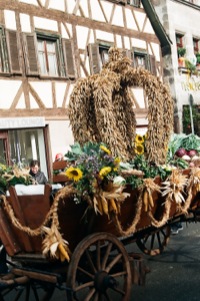
Agricultural floats were prominent, especially those from the Knoblauchland – the “Garlic Country” region north of Fürth. The floats bearing a Thanksgiving Crown carried enormous mass of vegetables tightly packed so as to form colorful pattern.
The Crown: its upward curving struts of straw and bound grain heads conveyed grace. Ten feet tall, the laborious construction stood witness to seed and soil and sun and rain. The crown also spoke of the farmer’s work compressed into a Thanksgiving aesthetic.
One of the Thanksgiving crowns at the Fürth parade was made of radishes, and one of mini-pumpkins, but the traditional Crowns of wheats, even though less colorful, evoked the deepest meaning of Thanksgiving. I didn’t get close enough to say what wheats were used for the Crowns, but judging by the length of straw on some of the floats, yes, ancient grains were part of the parade, they’re being raised again in this region.
After the parade the crowds streamed to the Kärwa carnival, a mile-long festival of food booths – breads and sausages, cheeses, chocolate, and fried spuds and Spätzle noodles and fish –, and beer huts, so many beer huts. Clearly it was a time to feast.
The Crown: its upward curving struts of straw and bound grain heads conveyed grace. Ten feet tall, the laborious construction stood witness to seed and soil and sun and rain. The crown also spoke of the farmer’s work compressed into a Thanksgiving aesthetic.
One of the Thanksgiving crowns at the Fürth parade was made of radishes, and one of mini-pumpkins, but the traditional Crowns of wheats, even though less colorful, evoked the deepest meaning of Thanksgiving. I didn’t get close enough to say what wheats were used for the Crowns, but judging by the length of straw on some of the floats, yes, ancient grains were part of the parade, they’re being raised again in this region.
After the parade the crowds streamed to the Kärwa carnival, a mile-long festival of food booths – breads and sausages, cheeses, chocolate, and fried spuds and Spätzle noodles and fish –, and beer huts, so many beer huts. Clearly it was a time to feast.

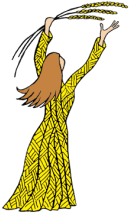
 RSS Feed
RSS Feed